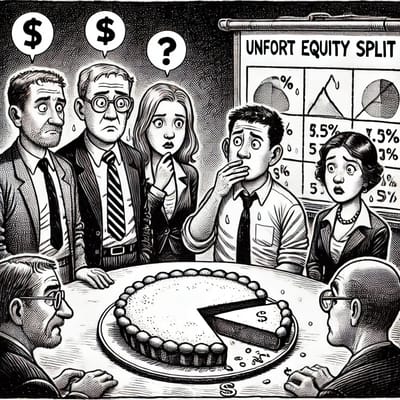The DNA of Great Founders

In the modern age of innovation, entrepreneurship is often hailed as a vital engine of economic growth and societal advancement. Governments understand this and attempt to write economic policy that supports innovation. Academic Institutions understand this and have created educational programs to produce “entrepreneurs.” Venture Accelerators, Incubators, and Studios - the modern-day startup factories - have made many attempts to define and replicate startup founder success. Every investor's eternal question is whether the startup's founders have what it takes to be the next great success story - to create a return on investment for shareholders. While specific entrepreneurial skills can be nurtured through education, the core attributes that define successful founders—such as risk tolerance, creativity, and resilience—are primarily innate and honed through deeply personal experiences. I further contend that it is possible to increase the probability of investing in the founders who are most likely to become successful by using a framework to evaluate entrepreneurial potential.
Dispelling the Myth that Entrepreneurship Can Be Taught
Studies indicate that successful entrepreneurs often possess distinct personality traits such as high-risk tolerance, proactivity, and a strong internal locus of control (Rauch & Frese, 2007). These traits are not easily taught or developed through traditional education. For example, a study by Zhao and Seibert (2006) found that entrepreneurs score significantly higher on traits such as openness to experience and conscientiousness than the general population. These traits are critical for identifying and exploiting new opportunities, but they are deeply rooted in individual personality. Creativity is a cornerstone of entrepreneurial success, enabling entrepreneurs to develop novel solutions and differentiate their ventures in competitive markets (Amabile, 1996). While creative thinking can be encouraged, the ability to consistently generate innovative ideas often stems from an intrinsic creative drive. Research by Ward (2004) suggests that creative problem-solving in entrepreneurship is linked to cognitive processes that are difficult to teach, such as associative thinking and the ability to draw insights from diverse experiences.
Real-world entrepreneurial success is frequently a product of learning from failure and iterating on business models. This experiential learning process is difficult to replicate in classroom settings (Cope, 2011). Case studies of entrepreneurs like Thomas Edison, who famously iterated on thousands of prototypes before perfecting the electric light bulb, underscore the importance of resilience and experiential learning in entrepreneurship (Conot, 1979). Entrepreneurship is inherently context-specific, relying on a nuanced understanding of particular industries, markets, and customer needs. This contextual knowledge is often gained through direct engagement and cannot be fully imparted through standardized curricula (Shane, 2000). For instance, the unique market insights that enabled Howard Schultz to transform Starbucks were acquired through his extensive experience in the coffee industry, illustrating the limitations of classroom-based entrepreneurship education (Schultz & Yang, 1997).
The founder’s journey is highly individualized and shaped by many factors, including personal background, industry conditions, and serendipitous opportunities. A standardized educational approach fails to accommodate this diversity (Neck & Greene, 2011). founders like Richard Branson and Elon Musk have followed vastly different paths to success, emphasizing the personalized nature of entrepreneurial journeys (Dearlove, 2007). Effective entrepreneurship education should foster adaptability and continuous learning rather than imparting a fixed set of skills. However, traditional educational structures are often ill-suited to this dynamic and fluid learning process (Rae, 2006).
Mapping the DNA of Great Founders
Accurately identifying potentially successful founders is the leading cause of better investment returns. Investors aim to find the next Steve Jobs or Jeff Bezos before they become Steve Jobs or Jeff Bezos. While traditional academic research has effectively documented the traits of successful founders, it is rooted in the retrospective. Traditional research doesn’t adequately and proactively identify emerging entrepreneurs’ potential.
Drawing from nearly 25 years of deep immersion in the startup ecosystem, I've developed a framework to identify the core DNA elements of founders with the greatest potential for success. These elements include passion, will, and ambition. They are the bedrock of investment decisions.
Passion is the presence of a steadfast hypothesis supported by an ability to convince others. This element drives founders to believe deeply in their vision and persuade others to join their cause. Passion is not merely about enthusiasm but a profound commitment to an idea or mission central to the founder’s identity. This passion fuels the founder’s perseverance, enabling them to overcome obstacles and remain dedicated to their goals despite adversity. The ability to articulate and share this passion with others is crucial, as it attracts investors, partners, and customers who are critical for the venture's success.
This was the undercurrent for one of my favorite founders, Sara Blakely. Blakely is the inventor and founder of Spanx shapewear for women. An inexperienced female founder selling to a manufacturing world controlled by men was no easy nut to crack.
Blakely's ability to articulate her vision and passion convinced investors, retailers, and customers to support Spanx. From her initial investment of $5,000, she built a billion-dollar company. If you listen to some of her presentations, you can sense the deep belief in her product and mission that drove her to overcome numerous obstacles.
Will refers to the rare discipline required to defy the laws of probability. Founders must be determined to push through inevitable setbacks and challenges in ways that few others can imagine. This willpower is characterized by a maniacal removal of barriers, a willingness to take risks, and an extraordinary capacity for hard work. Unlike mere persistence, Will involves a strategic and focused effort to achieve long-term objectives, often requiring the founder to navigate uncertainty and make tough decisions. This ironclad Will distinguishes successful founders from those who will falter when confronted with difficulties. The founder’s Will is the engine that drives the venture forward, constantly seeking new opportunities and innovative solutions to problems.
Show me a successful founder, and I will show you one who has failed. Few people don’t know about the live-action camera technology called GoPro. GoPro turned founder Nick Woodman into an entrepreneurial success story. But before GoPro, Woodman was a failed founder.
His first startup was empowerall.com, an online platform that sold electronic products at low margins to empower consumers with affordable prices. EmpowerAll failed to gain much traction, and Woodman failed to convince investors to support his venture. Not to be deterred, Woodman doubled down on his startup dreams, putting his own money and that of investors into Funbug, an online gaming and marketing platform that combined casual games with sweepstakes. Despite solving the Rubik's cube of funding, Funbug was a financial disaster.
As an investor, these are the things that interest me. I know of the many sleepless nights that Woodman must have suffered during the collapse of his second startup attempt. I know he torched personal relationships in the process. What I don’t know, and what I would ask, rather rhetorically, is what on earth would possess him to do it again.
Finally, Ambition is a unique and highly individualistic source of motivation. Founders are driven by personal goals and aspirations that fuel their journey and set them apart. Ambition involves a strong desire to achieve something significant. This is about possessing the vision and courage to pursue that which others won’t or have deemed ‘impossible.’ It often stems from a deep-seated need to create, innovate, and leave a lasting legacy.
Ambition is sometimes derived from a healthy “chip on the shoulder,” an instinctual urge to rise up and prove others wrong. Ambition gives founders a sense of purpose and direction, motivating them to push beyond conventional limits and explore uncharted territories. This ambitious drive propels them to scale their ventures, disrupt industries, and achieve remarkable feats.
Most people know Jan Koun as the billionaire co-founder of WhatsApp. It’s easy to appreciate and admire his success. But for me, his story before the fame of WhatsApp provides important DNA clues. Koum was born in Kyiv, Ukraine, and grew up in a small village. At 16, he immigrated to the United States with his mother to escape post-Soviet Ukraine's political instability and economic hardships. His family finally settled in Mountain View, California, where they lived in government-subsidized housing and relied on food stamps.
I have never met Jan Koun, but I know his future was set in motion during those difficult years. Ambition was cultured out of the pursuit of stability and prosperity, a common DNA trait among immigrant founders.
The combination of Passion, Will, and Ambition forms a unique experiential DNA that is difficult to replicate through traditional educational methods and is impossible to reproduce in a laboratory setting. These elements are deeply ingrained in the individual's character and are often shaped by personal experiences and intrinsic motivations developed as far back as adolescence. While educational programs, incubators, and accelerators can provide valuable business knowledge, skills, and frameworks, the essence of entrepreneurship—characterized by this experiential DNA—transcends conventional teaching methods and forms the basis from which investors can better evaluate founder potential.
References
Amabile, T. M. (1996). Creativity in Context: Update to the Social Psychology of Creativity. Boulder, CO: Westview Press.
Conot, R. (1979). A Streak of Luck: The Life and Legend of Thomas Alva Edison. New York, NY: Seaview Books.
Cope, J. (2011). Entrepreneurial learning from failure: An interpretative phenomenological analysis. Journal of Business Venturing, 26(6), 604-623.
Dearlove, D. (2007). Business the Richard Branson Way: 10 Secrets of the World's Greatest Brand Builder. Chichester, UK: Capstone.
Neck, H. M., & Greene, P. G. (2011). Entrepreneurship education: Known worlds and new frontiers. Journal of Small Business Management, 49(1), 55-70.
Rae, D. (2006). Entrepreneurial learning: A conceptual framework for technology-based enterprise. Technology Analysis & Strategic Management, 18(1), 39-56.
Rauch, A., & Frese, M. (2007). Let's put the person back into entrepreneurship research: A meta-analysis on the relationship between business owners' personality traits, business creation, and success. European Journal of Work and Organizational Psychology, 16(4), 353-385.
Schultz, H., & Yang, D. J. (1997). Pour Your Heart Into It: How Starbucks Built a Company One Cup at a Time. New York, NY: Hyperion.
Shane, S. (2000). Prior knowledge and the discovery of entrepreneurial opportunities. Organization Science, 11(4), 448-469.
Ward, T. B. (2004). Cognition, creativity, and entrepreneurship. Journal of Business Venturing, 19(2), 173-188.
Zhao, H., & Seibert, S. E. (2006). The Big Five personality dimensions and entrepreneurial status: A meta-analytical review. Journal of Applied Psychology, 91(2), 259-271.
No spam, no sharing to third party. Only you and me.




Member discussion